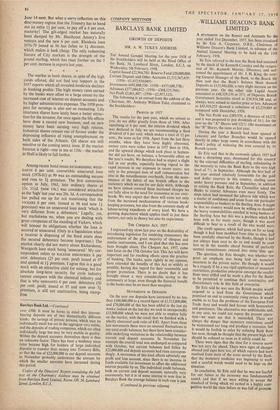COMPANY NOTES
By CUSTOS
THE lists of subscriptions to the new
, £500 million Exchequer 51 per cent.
1966 stock at 99 duly closed, on the
day of their opening (Tuesday), but it is expected that less than a third was sub- scribed outside the public departments. The banks, however, should find an eight-year stock with a running yield of £5 10s. 7d. per cent. very attrac- tive—the next highest yield on a 'short' being £4 14s. per cent. on Conversion 41 per cent. 1962. The issue is required indirectly to replenish the government departments' portfolio shelves, directly to provide for the redemption of the £676 million of Conversion 4 per cent. stock due on
June 14 next. But what a sorry reflection on this dear-money regime that the Treasury has to hand out an extra 1+ per cent. to pay off a 4 per cent. maturity! The gilt-edged market has naturally been damped by Mr. Heathcoat Amory's first venture and the new 6 per cent. Rhodesia loan 1976-79 issued at 96 has fallen to 1+- discount, which makes it look cheap. The only redeeming feature of City markets is the strength of the pound sterling, which has risen further on the 5 per cent. increase in exports last year,
The market in bank shares, in spite of the high yields offered, did not find any support in the 1957 reports which all revealed moderate declines in banking profits. The high money rates earned by the banks were offset to a large extent by the increased cost of interest on deposit accounts and by higher administrative expenses. The 1958 pros- pect for earnings is also not so reassuring. Life insurance shares have lately been a better attrac- tion for the investor, for once again the life offices have done a record new business; and on new money have been earning very high returns. Industrial shares remain out of favour under the depressing influence of rising unemployment on both sides of the Atlantic. Oil shares are still sensitive to the coming SHELL issue. If the market forecast is right—one in ten at 110s.—the market in Shell is likely to fall farther.
Among recent bond issues RICHARDSONS, WEST- GARTH 6 per cent. convertible unsecured loan stock (1976-81) at 99 was an outstanding success and rose to 3+ premium. The first conversion option in July, 1961, into ordinary shares at 15s. 1 1 Id. (now 14s.) was considered attractive as the `high' last year was 20s. 3d. A correspondent has pulled me up for not mentioning that the VICKERS 6 per cent. (issued at 96 and now 1+ premium) was an unsecured loan stock `which is very different from a debenture.' Legally, yes, but marketwise no, when you are dealing with great companies of the standing of Vickers, which will honour its obligations whether the loan is secured or unsecured. (Only in a liquidation when a receiver is disposing of the fixed assets does the secured debenture become important.) The market clearly did not worry about Richardsons, Westgarth loan stock being `unsecured.' My cor- respondent refers to RALEIGH INDUSTRIES 6 per cent. debenture (25 per cent. paid) issued at 97 and quoted at 14 premium. I agree this is a good stock with an attractive yield for mixing, but for absolute long-term security the cycle industry cannot compare with the chemical industry and that is why MONSANTO 6 per cent. debenture (50 per cent. paid), issued at 95 and now over 51 premium, is still not unattractive, being stamp- free.































 Previous page
Previous page